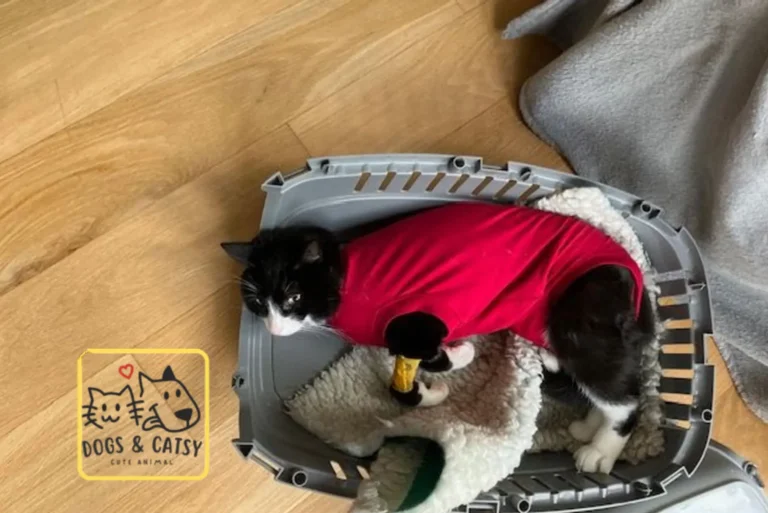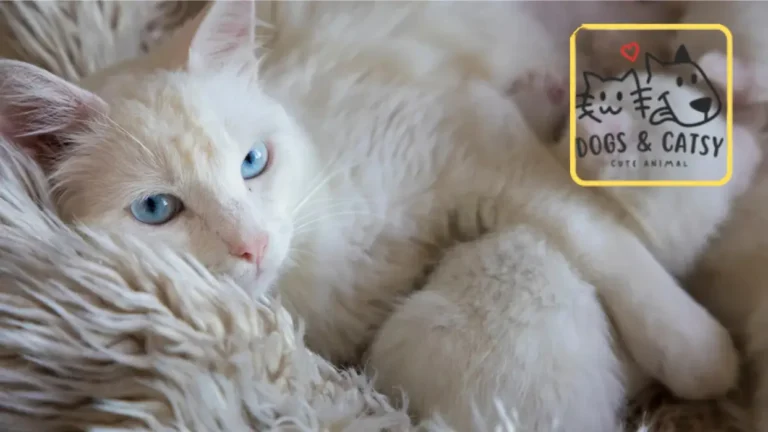What Makes a Black Cat with a White Chest Special? Revealed

A black cat with a white chest is often called a “tuxedo” cat due to its distinctive, formal-looking coat. This striking pattern is not a breed-specific trait but a common color variation among many breeds of cats. The white patch is typically caused by a genetic trait that restricts the color to specific parts of the body. This type of coloring can make tuxedo cats stand out in terms of appearance, and they are often associated with unique personality traits such as high intelligence and sociability. If you own a black cat with a white chest, you’re not just a pet owner—you’re the companion to a cat with one of the most charming and beloved coat patterns.
Black Cat with White Chest
A black cat with a white chest, often known as a tuxedo cat, is easily recognizable by its striking coloration that resembles formal attire. These cats are not a specific breed but a pattern found in various cat breeds.
Their unique appearance, combined with their friendly and playful personalities, makes them a favorite among cat lovers. Tuxedo cats are known for being smart, affectionate, and great companions.
What Breed of Cat is a Tuxedo Cat?
Tuxedo cats aren’t a specific breed but a color pattern that can be found in various breeds, including the American Shorthair, British Shorthair, and Maine Coon.
The term “tuxedo” describes their distinctive black and white coloration, which resembles formal wear. This striking pattern is not linked to any particular breed, making it a delightful surprise in many types of cats. Tuxedo cats are beloved for their elegant appearance and charming personalities.
Also Read: Black Cat with Orange Eyes
Bicolor Cats Aren’t Limited to Black and White
While tuxedo cats are primarily recognized for their black and white coats, bicolor cats can also display a variety of other color combinations. These include gray and white, orange and white, and even calico patterns.
The defining characteristic of these cats is the striking contrast between their two distinct colors, which creates an eye-catching and unique appearance. This variety adds to the charm and appeal of bicolor cats, making each one a delightful visual treat.
From “Locket” to “Harlequin”: Bicolor Cat Patterns
Bicolor cat patterns vary widely. Some common patterns include:
| Grade | Pattern | Description | Key Features |
|---|---|---|---|
| Low-Grade | Locket | A small, singular white patch on the chest. | Minimal white, mainly on the chest. |
| Tuxedo | White on the chest and belly, resembling a formal suit. | Predominantly colored, formal appearance. | |
| Medium-Grade | Standard Bicolor | An equal balance of white and a secondary color. | Symmetric color distribution across the body. |
| Mask-and-Mantle | Appears as if wearing a colored mask and cape. | More colored areas than white, dramatic contrast. | |
| High-Grade | Cap-and-Saddle | Colored cap on the head and a small saddle of color on the back. | Color mainly on the head (between the ears) and the tail, the rest of the body is white. |
| Harlequin | Predominantly white with sporadic, small colored spots. | Mostly white, with random small colored spots. | |
| Van | Color mainly on the head (between the ears) and the tail, rest of the body is white. | Extreme white dominance with limited colored patches. |
This table provides a clear and concise overview of the different patterns and their distinctive features, making it easy to understand the complexity and beauty of bicolor cat coats.
Tuxedo Cat Personality
Tuxedo cats are known for their friendly and outgoing personalities. They are often affectionate, and social, and enjoy being around people. Some key traits include:
- Playfulness: Tuxedo cats are known for their playful nature.
- Intelligence: They are quick learners and can be trained easily.
- Affectionate: They form strong bonds with their owners.
Gender Prevalence in Tuxedo Cats
Contrary to patterns observed in calico and tortoiseshell cats, where genetic makeup strongly influences both coat color and gender—resulting in nearly all being female—tuxedo cats do not exhibit a similar gender bias.
The distinctive black and white pattern of tuxedo cats is determined by a separate set of genetic factors unrelated to those affecting gender. Consequently, the distribution of male and female tuxedo cats is balanced.
This pattern can manifest in an offspring regardless of whether either parent exhibits tuxedo coloring, provided the essential genes for black and white fur are inherited. Thus, the tuxedo pattern is uniquely independent from gender-linked genetic traits.
Tuxedo Cats in Popular Culture
Tuxedo cats, often referred to as Felix cats after the famous cartoon character, are a staple in various forms of media, reflecting their iconic status in popular culture.
These black and white cats are featured extensively across television, video games, and films.
Notable Television Appearances:
- Felix the Cat
- Sylvester from Looney Tunes
- Tom from The Tom and Jerry Show
- The Cat in the Hat by Dr. Seuss
- Mr. Mistoffelees from the Cats Broadway show
Prominent Roles in Video Games:
- Cait Sith from Final Fantasy VII
- Rover from Animal Crossing
- Morgana from Persona 5
- Big the Cat from Sonic the Hedgehog
- Unsinkable Sam from World of Warships
Memorable Movie Cameos:
- The Nine Kittens of Christmas (2021)
- Luca (2021)
- John Wick: Chapter 3 (2019)
- Ma (2019)
- Les Misérables (2012)
- Bright Star (2009)
- Doubt (2008)
- Raiders of the Lost Ark (1981)
Also read: Calico Cat With Blue Eyes
Tuxedo Cats Are Famous
Tuxedo cats have been popularized through literature, film, and television. They have a reputation for being charming and intelligent, adding to their appeal.
And They’ve Had Many Famous Owners
Tuxedo cats have been associated with notable historical figures and cultural beliefs, highlighting their prominence throughout history.
Notable Historical Figures:
- William Shakespeare: The legendary playwright had a tuxedo cat named Tibbles.
- Sir Isaac Newton: The renowned physicist owned a tuxedo cat named Spithead.
Prominent Tuxedo Cats in Modern Times:
- Socks: Chelsea Clinton’s tuxedo cat, Socks, lived in the White House during President Bill Clinton’s administration from 1993 to 2001. Socks was an adopted stray and became famously known as the First Cat of the United States.
Tuxedo Cats in Ancient Cultures:
- In ancient Egypt, dating back to around 3200 BC, cats, including many tuxedo cats, were revered not as pets but as deities. A significant portion of the felines depicted in Egyptian art are identified as tuxedo cats, demonstrating their esteemed status in one of the world’s oldest civilizations.

The Richest Cat in the World… for a Little While
Tuxedo cats have not only captured hearts with their charming appearances but have also been notable for their inherited fortunes. Sparky, a tuxedo cat, once held the title of the world’s richest cat.
In 1998, he inherited $6.3 million after his owner passed away. However, this record was later surpassed by Tommaso, a black cat from Italy, who inherited $13 million, showcasing the substantial legacies that some pets can receive.
Last but Not Least: Magical Powers?
There’s an amusing piece of folklore involving tuxedo cats and their unique coat colors. It’s said that during the vernal or autumnal equinox, these cats can become invisible.
While this idea is not based on scientific facts, it adds a charming and mysterious element to the lore surrounding these distinctively patterned cats. Such stories highlight how tuxedo cats capture the imagination and contribute to their mystical appeal in popular culture.
Are Tuxedo Cats Rare?
Tuxedo cats are not rare. Their distinctive coat pattern is relatively common among domestic cats.
Do Tuxedo Cats Have Health Problems?
Tuxedo cats, like all felines, can experience common health issues, but their striking black and white coat is not linked to any specific genetic health problems.
These cats share the same potential for health as any other cat coloration, meaning their care involves regular veterinary check-ups and a healthy lifestyle to ensure they lead vibrant, full lives.
Also read: Why Do Cats Shake Their Heads When They Eat?
What is the Life Expectancy of a Tuxedo Cat Indoors?
Tuxedo cats living indoors typically enjoy a life expectancy of 12 to 20 years, thriving in a safe, controlled environment. Regular veterinary care, a balanced diet, and a loving home can extend their lifespan, allowing these charming cats to be longtime, affectionate companions.
Do Tuxedo Cats Like to be Held?
Many tuxedo cats enjoy being held and cuddled, but this can vary based on their personality. Socialization and positive experiences can increase their comfort with being held.
Why Are Tuxedo Cats So Special?
Tuxedo cats are special for several reasons that make them stand out among other felines. Firstly, their distinctive black and white coat, resembling formal attire, gives them a charming and sophisticated appearance.
Additionally, tuxedo cats are often celebrated in culture and media, and featured as characters in many cartoons and movies, which enhances their allure.
Their personalities are also a draw; they are known for being particularly social, intelligent, and affectionate, traits that endear them to cat lovers around the world.
How Smart Are Tuxedo Cats?
Tuxedo cats are known for their remarkable intelligence, often displaying clever and curious behaviors that set them apart. They excel in problem-solving and interaction, making them engaging and responsive pets.
This sharp intelligence not only makes them fun companions but also quick learners, adept at mastering new tricks and understanding household routines.
What Color Eyes Do Tuxedo Cats Have?
Tuxedo cats can have a variety of eye colors, with the most common being golden, green, or blue.
The specific eye color of a tuxedo cat often depends on their genetics, with no particular color being exclusive to their black and white coat pattern. This diversity in eye color adds to their striking appearance and individual charm.
How to Take Care of a Tuxedo Cat?
To take care of a tuxedo cat:
- Regular Vet Visits: Ensure they receive vaccinations and check-ups.
- Balanced Diet: Provide high-quality cat food.
- Grooming: Brush their fur regularly to reduce shedding.
- Exercise: Engage them with toys and playtime.
How to Train a Tuxedo Cat?
Here are some straightforward tips for effective training of a tuxedo cat:
- Start Simple: Begin with easy tasks to build confidence.
- Short Sessions: Keep training brief to maintain focus.
- Minimize Distractions: Ensure a quiet, undisturbed environment.
- Immediate Rewards: Provide consistent, timely rewards for positive actions.
- Appropriate Rewards: Choose incentives that motivate effectively.
- Avoid Punishment: Focus on reinforcing good behaviors instead of punishing the bad.
- Consistent Cues: Use the same signals each time to avoid confusion.
- Optimal Timing: Train when your trainee is alert and receptive, not tired or distracted.
Conclusion
Tuxedo cats, with their black and white coats, are not just visually striking but also boast friendly and intelligent personalities. They hold a special place in pop culture and the hearts of their owners. Whether you’re considering adopting one or already have a tuxedo cat, they are sure to bring joy and companionship into your life.
FAQs
What breed of cat is a tuxedo cat?
Tuxedo cats aren’t a specific breed but a color pattern seen in various breeds.
Are tuxedo cats aggressive?
Tuxedo cats are generally friendly and not known for aggression.
Are tuxedo cats expensive?
The cost depends on the breed, not the color pattern.






